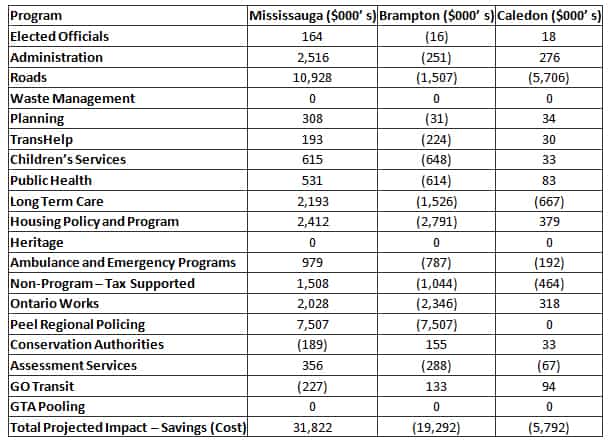How Much Would Mississauga Save if it Left the Region of Peel?
Published January 31, 2018 at 6:06 pm

There’s been trouble brewing in the Region of Peel — a region consisting of Mississauga, Brampton and Caledon — for sometime and Mississauga mayor Bonnie Crombie has been looking to fulfill an old Hazel McCallion mandate and exit the region to form a single tier, autonomously governed City of Mississauga.
While the prospect has angered Brampton mayor Linda Jeffrey and prompted Caledon mayor Allan Thompson to beseech the battling magistrates to “move on” and stick with former Premier Bill Davis’ vision, it’s no surprise that Mississauga wants out.
Exiting the region would, a report suggests, benefit the city.
It just would do so at Brampton and Caledon’s expense (quite literally, in fact).
According to a report, titled the Financial Report on the Transition of Mississauga to a Single Tier City, Sauga could save a striking amount of cash should it go its own way and effectively stop subsidizing its smaller neighbours.
The report, produced by Day and Day Chartered Accountants, has data from 2003 (the most recent available, it appears), but the numbers — though not up to the minute — tell an enticing story. It suggests Mississauga could save about $32 million a year and that residents could see their property taxes dip by six per cent.
The report assumes that, in the event of a regional breakdown, each of the three cities will form their own independent governments. It’s also clear that while its numbers should be accurate enough, the firm is basing its projections on certain assumptions.
“We predict the following financial impacts on Mississauga, Brampton and Caledon as a result of the creation of a single tier City of Mississauga,” the report says. “It is important to note that our predictions of financial impact consider both amalgamation savings as well as impacts resulting from a re-apportionment of existing Region of Peel program costs to reflect actual costs predicted to be incurred by each single tier municipality. We believe our predictions of financial impact to be realistic, however wish to point out that the final outcomes will be directly dependant upon the decisions of municipal councils and administrations.”
Here’s the first savings chart, produced in the report:

Here are the projected property tax impacts, based on a residential property worth $250,000:

As you can see, an exit would buffer Mississauga’s coffers while putting Brampton and Caledon in the hole.
At present, Peel ensures that several essential services — police, waste management, social services, social housing and ambulances — are shared across the region. School boards, though titled after their respective regions, are not run by cities and therefore wouldn’t be affected in the event of a split.
While regional government is, in theory, efficient, it has its imperfections. In the case of Mississauga, the discontent stems from the city’s disproportionate burdens — especially regarding the modestly populated town of Caledon.
As for whether or not Mississauga is moving forward on the file, the city says it will be considering its options after the upcoming provincial and regional elections.
“Mississauga continues to work to ensure the Region of Peel works in the best interests of our residents and that we receive our fair share for the money we invest – close to 60 per cent of all Region funding comes from Mississauga,” Mississauga Mayor Bonnie Crombie told inSauga.com in an email statement.
“Now that the Regional Chair will be elected, this will create a new dynamic. As well, following the provincial election we will have greater clarity if the next government is willing to entertain changes to the Region of Peel. The current government has signalled that it is not.”
It’ll be interesting to see how the situation unfolds going forward.
insauga's Editorial Standards and Policies advertising





